Influence of Karst Reservoir Capacity on Flood in Lijiang Basin Based on Modified HEC-HMS through Soil Moisture Accounting Loss
Abstract
1. Introduction
2. Materials and Methods
2.1. Study Area
2.2. Methods Used
2.2.1. HEC-HMS Model and Its Extensions
2.2.2. Dams on Lijiang River
2.2.3. Soil Moisture Accounting Loss and the Use of Artificial Neural Network
3. Results
3.1. Initial Forecast via HEC-HMS
3.2. ARCK Impact on Flood Formation
3.3. Inclusion of Soil Moisture Accounting Loss for Model Modification
3.4. Modified Model Outputs
4. Discussion
5. Conclusions
Supplementary Materials
Author Contributions
Funding
Institutional Review Board Statement
Informed Consent Statement
Data Availability Statement
Acknowledgments
Conflicts of Interest
References
- Zhang, J.; Huan, X.; Lu, H.; Wang, C.; Shen, C.; He, K.; Lu, Y.; Wu, N. Crossing of the Hu line by Neolithic population in response to seesaw precipitation changes in China. Sci. Bull. 2022, 67, 844–852. [Google Scholar] [CrossRef]
- Liu, J.; Shi, Z. Quantifying land-use change impacts on the dynamic evolution of flood vulnerability. Land Use Policy 2017, 65, 198–210. [Google Scholar] [CrossRef]
- Jiang, G.; Guo, F.; Tang, C. Groundwater systems in bare and covered karst aquifers: Evidence from tracer tests, hydrochemistry, and groundwater ages. Environ. Earth Sci. 2019, 78, 608. [Google Scholar] [CrossRef]
- Willenbrink, E. Policy Communication and the Influence of Agricultural Communities on Karst Landscapes: A Case Study in Phong Nha-Kè Bàng National Park, Vietnam. Master’s Thesis, Western Kentucky University, Bowling Green, KY, USA, 2018. Paper 2076; Specialist Projects. Available online: https://digitalcommons.wku.edu/theses/2076 (accessed on 1 February 2022).
- Jiang, G.; Guo, F.; Wei, M. Hydrogeological characteristics of foot caves in a karst peak-forest plain in South China. Hydrogeol. J. 2020, 28, 535–548. [Google Scholar] [CrossRef]
- Choudhury, P.; Shrivastava, R.K.; Narulkar, S.M. Flood routing in river networks using equivalent Muskingum inflow. J. Hydrol. Eng. 2002, 7, 413–419. [Google Scholar] [CrossRef]
- Dastorani, M.T.; Khodaparast, R.; Talebi, A.; Vafakhah, M.; Dashti, J. Determination of the ability of HEC-HMS Model components in rainfall-run-off simulation research. J. Environ. Sci. 2011, 5, 790. [Google Scholar]
- Kabeja, C.; Li, R.; Guo, J.; Rwatangabo, D.E.R.; Manyifika, M.; Gao, Z.; Wang, Y.; Zhang, Y. The Impact of Reforestation Induced Land Cover Change (1990–2017) on Flood Peak Discharge Using HEC-HMS Hydrological Model and Satellite Observations: A Study in Two Mountain Basins, China. Water 2020, 12, 1347. [Google Scholar] [CrossRef]
- Sharafati, A.; Khazaei, M.R.; Nashwan, M.S.; Al-Ansari, N.; Yaseen, Z.M.; Shahid, S. Assessing the Uncertainty Associated with Flood Features due to Variability of Rainfall and Hydrological Parameters. Adv. Civ. Eng. 2020, 7948902. [Google Scholar] [CrossRef]
- Mo, C.; Wang, Y.; Ruan, Y.; Qin, J.; Zhang, M.; Sun, G.; Jin, J. The effect of karst system occurrence on flood peaks in small watersheds, southwest China. Hydrol. Res. 2021, 52, 305–322. [Google Scholar] [CrossRef]
- Delphi, M.; Shooshtari, M.M.; Zadeh, H.H. Application of Diffusion Wave Method for Flood Routing in Karun River. Int. J. Environ. Sci. Dev. 2010, 1, 432. [Google Scholar] [CrossRef]
- Tewolde, M.H.; Smithers, J. Flood routing in ungauged catchments using Muskingum methods. Water SA. 2006, 32, 379–388. [Google Scholar] [CrossRef]
- Zhang, H.L.; Wang, Y.J.; Wang, Y.Q.; Li, D.X.; Wang, X.K. The effect of watershed scale on HEC-HMS calibrated parameters: A case study in the Clear Creek watershed in Iowa, US. Hydrol. Earth Syst. Sci. 2013, 17, 2735–2745. [Google Scholar] [CrossRef]
- Nyaupane, N.; Mote, S.R.; Bhandari, M.; Kalra, A.; Ahmad, S. Rainfall-runoff simulation using climate change-based precipitation prediction in HEC-HMS Model for Irwin Creek, Charlotte, North Carolina. In Watershed Management, Irrigation and Drainage, and Water Resources Planning and Management, Proceedings of the World Environmental and Water Resources Congress, Minneapolis, MN, USA, 2018; American Society of Civil Engineers: Reston, VA, USA, 2018; pp. 352–363. [Google Scholar]
- Şen, Z. General modeling of karst spring hydrographs and development of a dimensionless karstic hydrograph concept. Hydrogeol. J. 2020, 28, 549–559. [Google Scholar] [CrossRef]
- Şen, Z.; Dabanlı, İ.; Şişman, E. Physical and practical hydrograph recession modeling in karstic sinkholes. Water Supply 2020, 20, 751–760. [Google Scholar] [CrossRef]
- Zhou, Q.; Chen, L.; Singh, V.P.; Zhou, J.; Chen, X.; Xiong, L. Rainfall-runoff simulation in karst dominated areas based on a coupled conceptual hydrological model. J. Hydrol. 2019, 573, 524–533. [Google Scholar] [CrossRef]
- Vereecken, H.; Schnepf, A.; Hopmans, J.W.; Javaux, M.; Or, D.; Roose, T.; Vanderborght, J.; Young, M.H.; Amelung, W.; Aitkenhead, M.; et al. Modeling soil processes: Review, key challenges, and new perspectives. Vadose Zone J. 2016, 15, vzj2015.09.0131. [Google Scholar] [CrossRef]
- Ghazanfari, S.; Pande, S.; Cheema, M.J.M.; Alizadeh, A.; Farid, A. The role of soil moisture accounting in estimation of soil evaporation and transpiration. J. Hydroinformatics 2016, 18, 329–344. [Google Scholar] [CrossRef]
- Wang, D. A new probability density function for spatial distribution of soil water storage capacity leads to the SCS curve number method. Hydrol. Earth Syst. 2018, 22, 6567–6578. [Google Scholar] [CrossRef]
- Li, R.; Chen, Q.; Tonina, D.; Cai, D. Effects of upstream reservoir regulation on the hydrological regime and fish habitats of the Lijiang River, China. Ecol. Eng. 2015, 76, 75–83. [Google Scholar] [CrossRef]
- Zeng, C.; Guo, C.; Hu, J. Researches on variation in water resources of up reaches of Lijiang River. Resour. Environ. Eng. 2005, 19, 203–207, (In Chinese with English Abstract). [Google Scholar]
- Huang, W. Spatial dimensions of tower karst and cockpit karst: A case study of Guilin, China. Ph.D. Thesis, The University of Wisconsin-Milwaukee, Milwaukee, WI, USA, 2014; p. 54. Available online: https://dc.uwm.edu/etd/626 (accessed on 25 May 2022).
- Rad, S.; Dai, J.; Xu, J.; Wan, Z.; Zitao, L.; Linyan, P. Lijiang Flood Characteristics and Implication of Karst Storage Through Muskingum Flood Routing Via HEC-HMS, S. China. Hydrol. Res. 2022, in press. [Google Scholar]
- Cao, Y.; Zhang, J.; Yang, M.; Lei, X.; Guo, B.; Yang, L.; Zeng, Z.; Qu, J. Application of SWAT Model with CMADS Data to Estimate Hydrological Elements and Parameter Uncertainty Based on SUFI-2 Algorithm in the Lijiang River Basin, China. Water 2018, 10, 742. [Google Scholar] [CrossRef]
- Xu, J.; Dai, J. Variation characteristics of runoff in upper reaches of Lijiang River basin. Yangtze River 2018, 49, 41–46, (In Chinese with English abstract). [Google Scholar]
- Qi, J.; Xu, M.; Cen, X.; Wang, L.; Zhang, Q. Characterization of Karst Conduit Network Using Long-Distance Tracer Test in Lijiang, Southwestern China. Water 2018, 10, 949. [Google Scholar] [CrossRef]
- Mao, X.; Meng, J.; Wang, Q. Modeling the effects of tourism and land regulation on land-use change in tourist regions: A case study of the Lijiang River Basin in Guilin, China. Land Use Policy 2014, 41, 368–377. [Google Scholar] [CrossRef]
- Yao, Y.; Mallik, A. Stream Flow Changes and the Sustainability of Cruise Tourism on the Lijiang River, China. Sustainability 2020, 12, 7711. [Google Scholar] [CrossRef]
- Guizhen, H.; Xiang, Z.; Mingzhao, Q.Y. Exploring the multiple distribution of karst landscape in Guilin World Heritage Site, China. Catena 2021, 203, 105349. [Google Scholar] [CrossRef]
- Dai, J.; Rad, S.; Xu, J.; Pen, S.; Gan, L.; Chen, X.; Yu, C.; Zhang, S. Impacts of Climate Change Versus Landuse Change on Recent Lijiang River Flood Regime, South China. Tecnol. Y Cienc. Del Agua 2021, 12, 257–303. [Google Scholar] [CrossRef]
- Veress, M. Karst types and their karstification. J. Earth Sci. 2020, 31, 621–634. [Google Scholar] [CrossRef]
- Jia, Z.; Liu, X.; Cai, X.; Xing, L. Quantitative Remote Sensing Analysis of the Geomorphological Development of the Lijiang River Basin, Southern China. J. Indian Soc. Remote Sens. 2019, 47, 737–747. [Google Scholar] [CrossRef]
- Brirhet, H.; Benaabidate, L. Comparison of Two Hydrological Models (Lumped and Distributed) Over A Pilot Area of The Issen Watershed in The Souss Basin, Morocco. Eur. Sci. J. ESJ 2016, 12, 347. [Google Scholar] [CrossRef][Green Version]
- Tassew, B.G.; Belete, M.A.; Miegel, K. Application of HEC-HMS model for flow simulation in the lake tana basin: The case of gilgel abay catchment, upper blue nile basin, Ethiopia. Hydrology. 2019, 6, 21. [Google Scholar] [CrossRef]
- Bailly-Comte, V.; Jourde, H.; Roesch, A.; Pistre, S.; Batiot-Guilhe, C. Time series analyses for karst/river interactions assessment: Case of the Coulazou river (southern France). J. Hydrol. 2008, 349, 98–114. [Google Scholar] [CrossRef]
- Van der Tol, C.; Verhoef, W.; Timmermans, J.; Verhoef, A.; Su, Z. An integrated model of soil-canopy spectral radiances, photosynthesis, fluorescence, temperature and energy balance. Biogeosciences 2009, 6, 3109–3129. [Google Scholar] [CrossRef]
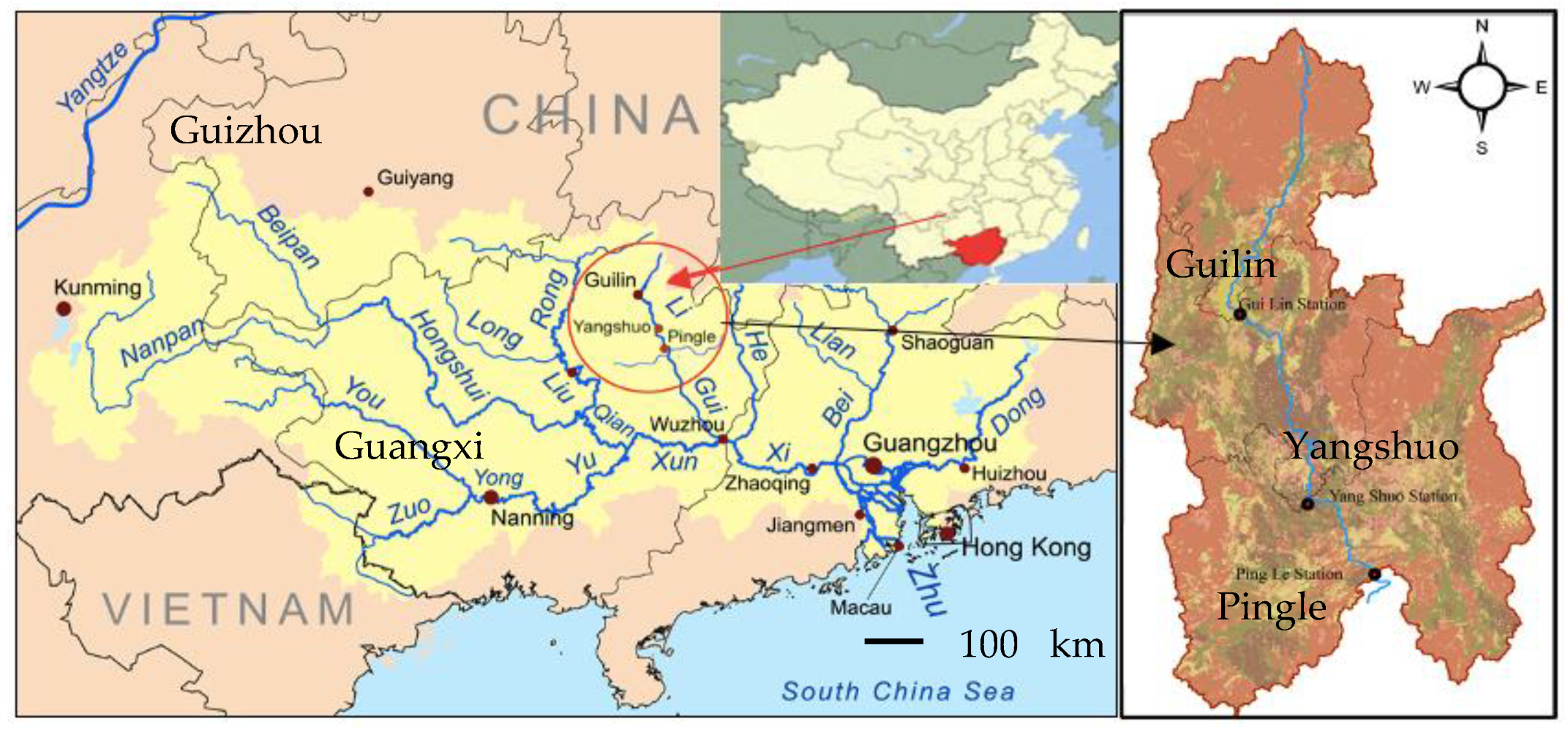
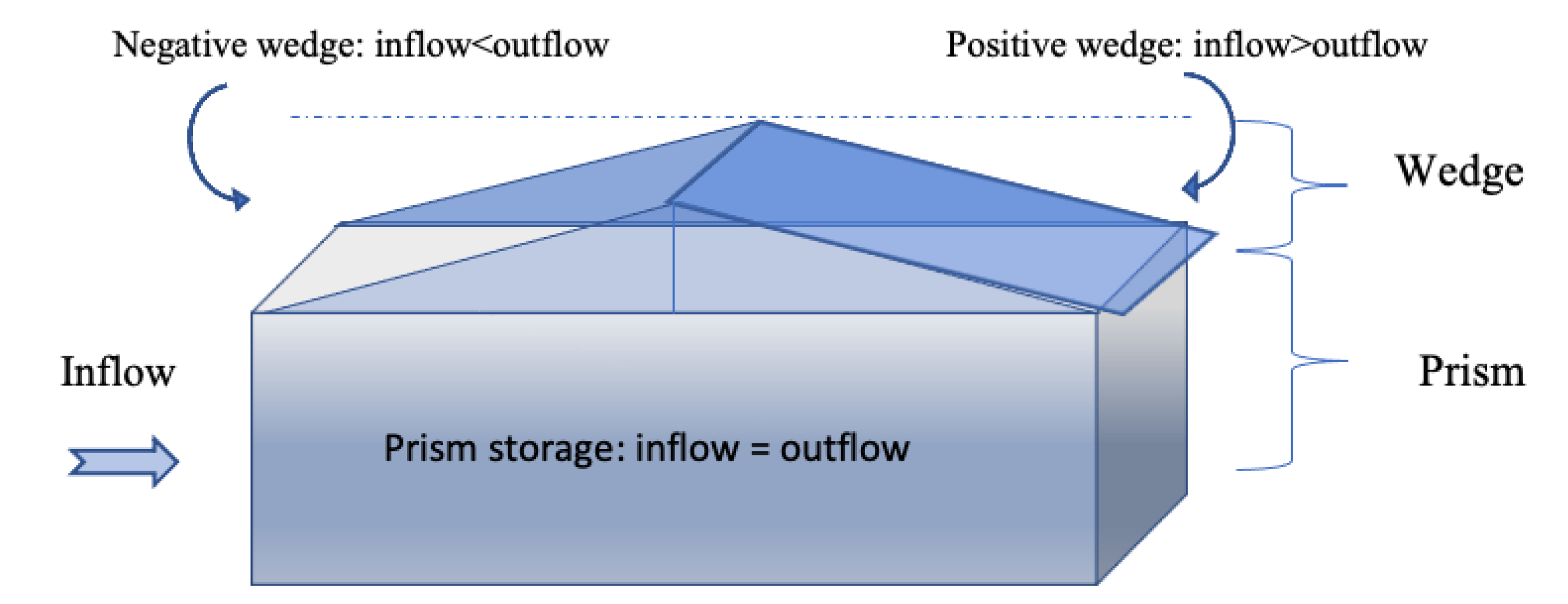
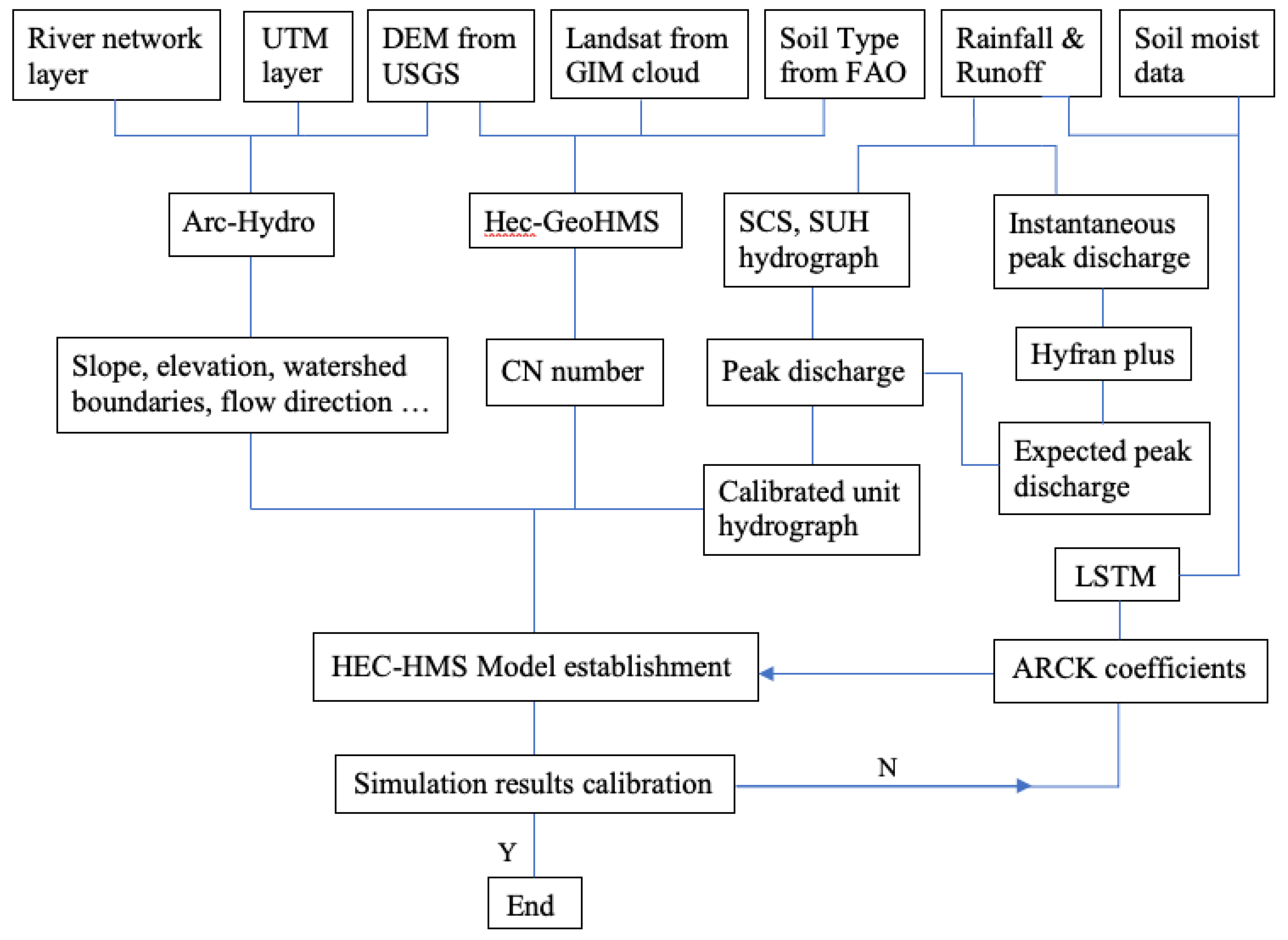

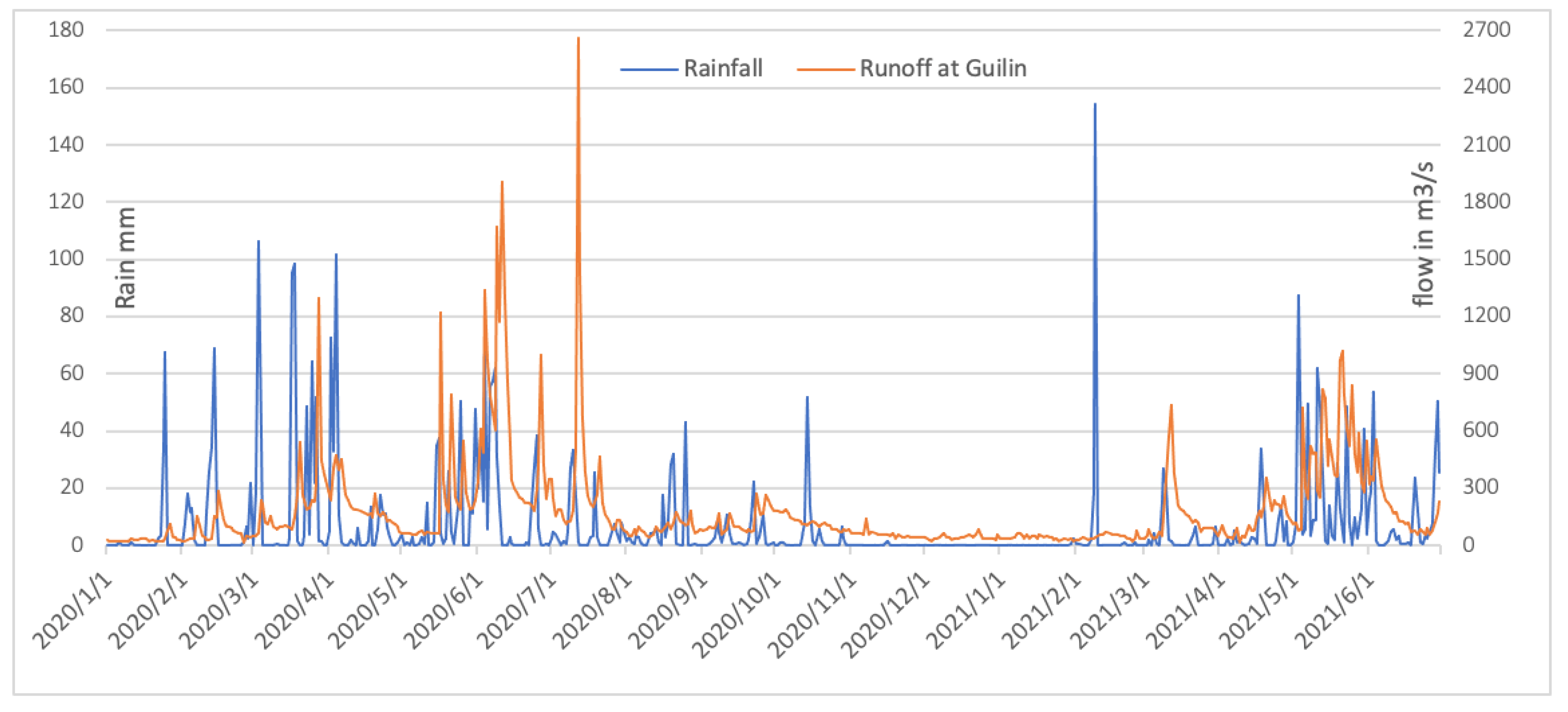
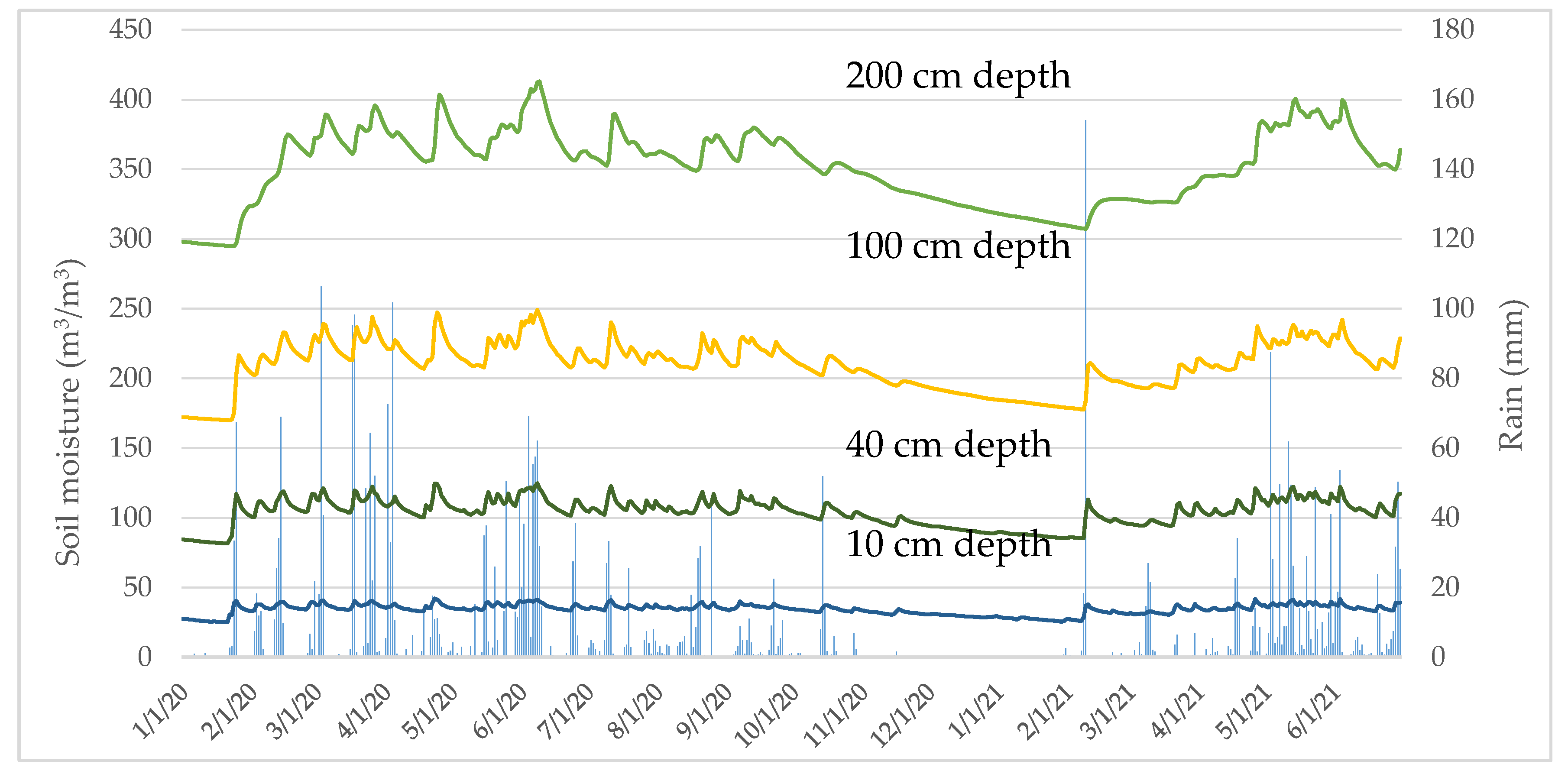

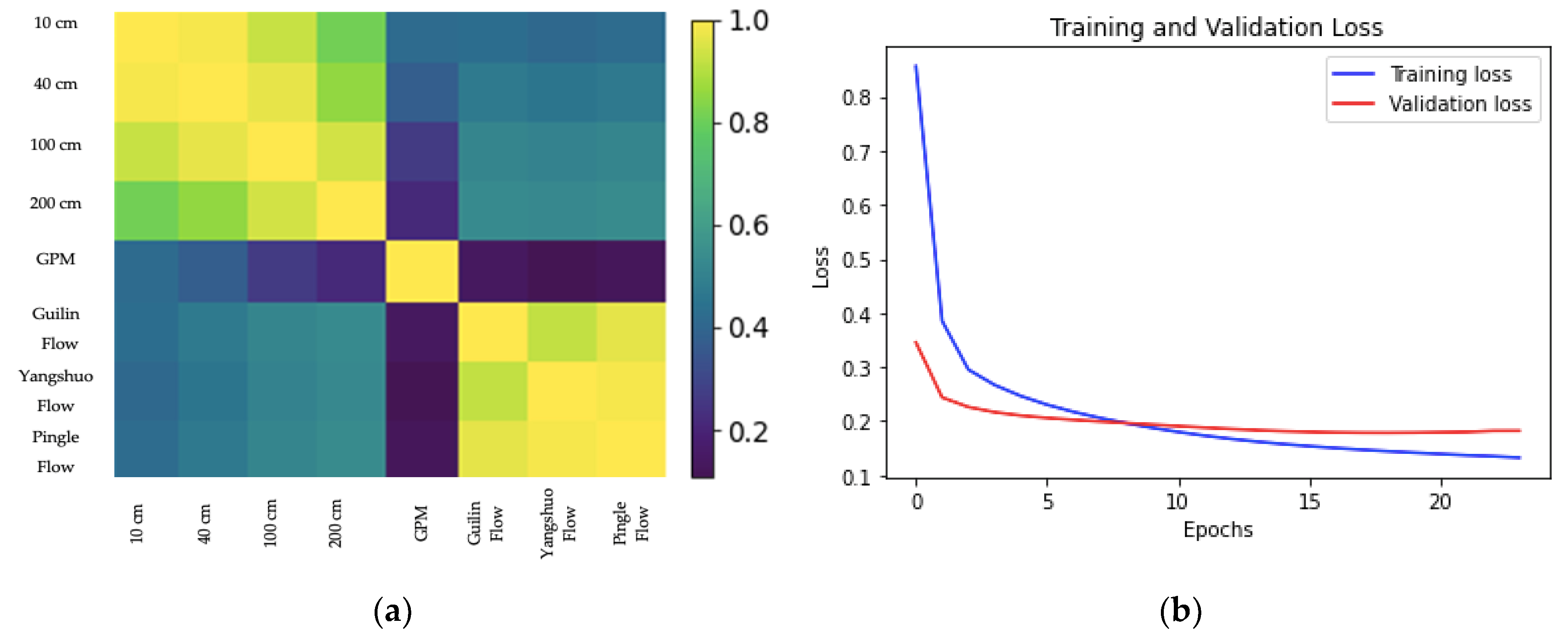
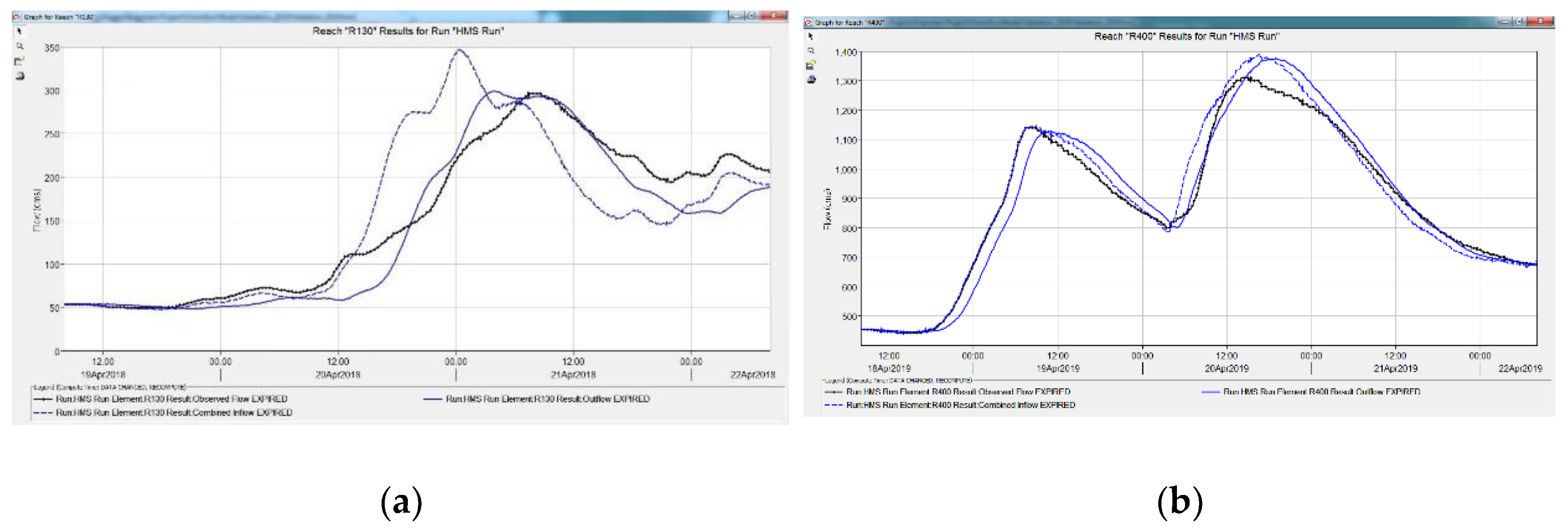

| NSE Values | 2017 G | 2017 Y | 2017 P | 2018 G | 2018 Y | 2018 P | 2019 G | 2019 Y | 2019 P |
|---|---|---|---|---|---|---|---|---|---|
| Initial | 0.44 | 0.36 | 0.48 | 0.69 | 0.88 | 0.29 | 0.29 | −1.24 | 0.53 |
| After Dams | 0.57 | 0.41 | 0.65 | 0.87 | 0.90 | 0.44 | 0.34 | 0.95 | 0.72 |
| After soil moist | 0.73 | 0.52 | 0.72 | 0.91 | 0.96 | 0.69 | 0.84 | 0.94 | 0.97 |
Publisher’s Note: MDPI stays neutral with regard to jurisdictional claims in published maps and institutional affiliations. |
© 2022 by the authors. Licensee MDPI, Basel, Switzerland. This article is an open access article distributed under the terms and conditions of the Creative Commons Attribution (CC BY) license (https://creativecommons.org/licenses/by/4.0/).
Share and Cite
Dai, J.; Rad, S.; Xu, J.; Wan, Z.; Li, Z.; Pan, L.; Shahab, A. Influence of Karst Reservoir Capacity on Flood in Lijiang Basin Based on Modified HEC-HMS through Soil Moisture Accounting Loss. Atmosphere 2022, 13, 1544. https://doi.org/10.3390/atmos13101544
Dai J, Rad S, Xu J, Wan Z, Li Z, Pan L, Shahab A. Influence of Karst Reservoir Capacity on Flood in Lijiang Basin Based on Modified HEC-HMS through Soil Moisture Accounting Loss. Atmosphere. 2022; 13(10):1544. https://doi.org/10.3390/atmos13101544
Chicago/Turabian StyleDai, Junfeng, Saeed Rad, Jingxuan Xu, Zupeng Wan, Zitao Li, Linyan Pan, and Asfandyar Shahab. 2022. "Influence of Karst Reservoir Capacity on Flood in Lijiang Basin Based on Modified HEC-HMS through Soil Moisture Accounting Loss" Atmosphere 13, no. 10: 1544. https://doi.org/10.3390/atmos13101544
APA StyleDai, J., Rad, S., Xu, J., Wan, Z., Li, Z., Pan, L., & Shahab, A. (2022). Influence of Karst Reservoir Capacity on Flood in Lijiang Basin Based on Modified HEC-HMS through Soil Moisture Accounting Loss. Atmosphere, 13(10), 1544. https://doi.org/10.3390/atmos13101544










